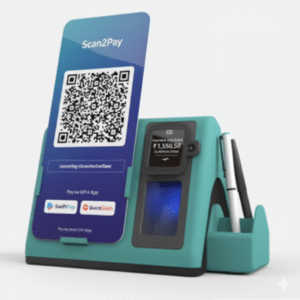Proxgy an Internet of Things (IoT) startup announces ThumbPay: A Biometric Device That Brings UPI to People Without Smartphones, Internet, Cards and Wallets.

Delhi-based IoT startup Proxgy has introduced ThumbPay, a device that supports users to make digital payments with just a thumbprint. By incorporating Aadhaar-based biometric authentication and UPI, ThumbPay empowers those without smartphones, debit cards, or internet access to complete cashless transactions.
Inclusive Digital Payments
Despite the fact that, India had processed nearly 14 billion transactions in June 2024, while the millions – especially the elderly, rural households, and low-income groups – remained excluded. ThumbPay aims to offer a one-touch payment solution to bridge this gap.
Digital payments must not remain limited only to those with smartphones. ThumbPay is built to ensure inclusivity, a Proxgy spokesperson said during the launch.
How ThumbPay Works
To make payment, customers will need to put their thumb on the device. The Aadhaar Enabled Payment System (AEPS) will verify the identity, then UPI payment will successfully complete the bank to bank transfer. This doesn’t needs to have any phones, debit card, PIN, or application for the payments.
The device has a certified fingerprint system with fraud detection, a mini camera for verification, UV sterilization for hygiene and options for QR and NFC payments. This functions similar to UPI soundbox and supports 4G, wifi, and LoRaWAN for those areas with poor network connectivity.
Pulkit Ahuja, Founder and CEO of Proxgy, said: “India did the hard work building Aadhaar and UPI over the last decade; ThumbPay is the creative synthesis of these platforms. ”
The company says ThumbPay can also streamline government subsidies, pension schemes, and benefit disbursements, where fast and secure verification is crucial.
Rollout & Cost
Proxgy aims to initially roll out ThumbPay across rural and semi-urban India via banking correspondents, microfinance agents, and retail partners. The company is working with fintech providers and state governments to scale adoption. The device will be available in shops later this year, with trial runs already happening in few states .
The ThumbPay device is priced nearly ₹2,000 with potential subsidies for large-scale government distribution and the device can be run on battery power, making it easier to use in the small shops, rural markets and larger retail outlets. Since the device requires direct link to bank account with Aadhaar number, anyone from such account can take the benefit of this device without any additional registration.
Ahuja also mentioned that ThumbPay has the potential to help the people who don’t have smartphones or doesn’t carry wallets, including the elderly people and daily wages workers. “We’re essentially bringing the power of UPI to every person’s fingertip – literaly.” – he said.
Challenges to Watch
While the device claims inclusivity, experts see potential concerns:
- Data Privacy & Security: Aadhaar-linked services often face scrutiny over biometric safety.
- Connectivity Issues: Real-time Aadhaar verification will still need reliable network support.
- Merchant Adoption: Widespread success depends only if shopkeepers and small vendors embrace the device.
Bigger Picture
ThumbPay aligns with India’s Digital India vision, where financial inclusion is focused. If adopted at scale, it could become a game-changer for the nearly 300+ million Indians who remain on the sidelines of the digital economy, proving that innovation can serve not just the urban elite but also the last mile.
